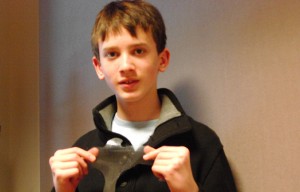The tiny, brown-and-white-mottled bird sat panting on a boulder by our porch on a warm July day last summer, its head cocked strangely to one side. It was a pine siskin, a small finch with bits of yellow on its folded wings. I worked at a wildlife rehab center some years ago, so I recognized the signs—blunt trauma to the head from flying into a window. Collisions with plate glass claims the lives of more than 100 million birds a year in the United States alone, perhaps as many as 1 billion a year throughout all of North America.
For years I’ve been hearing that domestic and feral cats are a big culprit in the decline of songbird populations—and they may well be—but some researchers are coming to the conclusion that window glass, especially in skyscrapers along migration routes, may be more to blame than cats. I can well believe it, judging by the number of sickening whumps I hear each summer from my house windows. At least once each year I head outdoors at the sound to find a small body stiffening on the ground.
When I lived in the Bay Area I followed the adventures of Gracie and George, the peregrine falcons nesting on the ledge of a skyscraper in downtown San Francisco. Thousands of humans ogled the couple’s intimate adventures by way of a nestcam discreetly placed on the ledge. One spring we all cheered when Gracie’s four eggs hatched safely into fluffy, bemused chicks. We watched them grow and flex their wings until one by one they sailed off their perch, flying at last. All, that is, except one, who headed straight into the glass of the office building across the street and was killed instantly. I wondered, despairing, isn’t there something that can be done to warn birds about glass?
Now there is. According to a CBC story (thanks to Mirabilis), Charlie Sobcov, an eighth-grader from Ottawa, Canada, has developed a decal to apply to glass to warn birds away from windows. Decals, of course, have been used for this purpose for years, especially decals in outlines of hawks. No songbird in its right mind will head straight for a predator. But the trouble with decals is they’re opaque, which means they block out a portion of the window and interfere with the view.
Not Charlie Sobcov’s decals. He invented plastic decals that can be placed in the middle of the window but remain invisible. To humans, that is. To birds they look like the outline of a hawk because birds can see the ultraviolet end of the spectrum, and the decals are painted with an ultraviolet-colored paint. To the rest of us, the decals look nearly transparent.

Photo by Emily Chung/CBC
Maybe Charlie’s invention would have saved the life of the pine siskin outside my house last July. I picked the bird up gingerly, put it in a shoebox with some small branches to perch on, and took it inside to keep it safe from neighborhood cats. Sometimes window-crashed birds, resting for an hour or so, can recover their wits and fly away.
An hour passed, then a half hour more, with the bird sitting quietly, panting. Then its movement picked up as it scrambled for a twig to perch on. I was called out of the room for only a moment. I returned to find the bird lying on its side, the underlids of its eyes already frozen across the milky pupils.
I think I’ll email Charlie and ask to purchase some of his decals. I’m tired of hearing that whump on my windows. Excellent work, Charlie! You’re my hero.
For more on birds and windows and how to prevent collisions, see FLAP, the Fatal Light Awareness Program, in Toronto, Canada.
Statistics on birds and collisions with windows are available from Daniel Klem Jr., an ornithologist at Muhlenberg College in Pennsylvania.